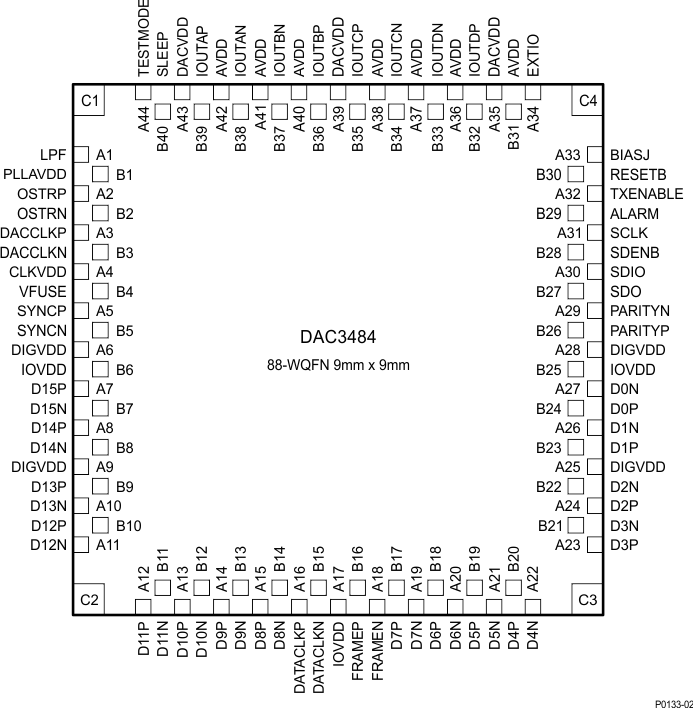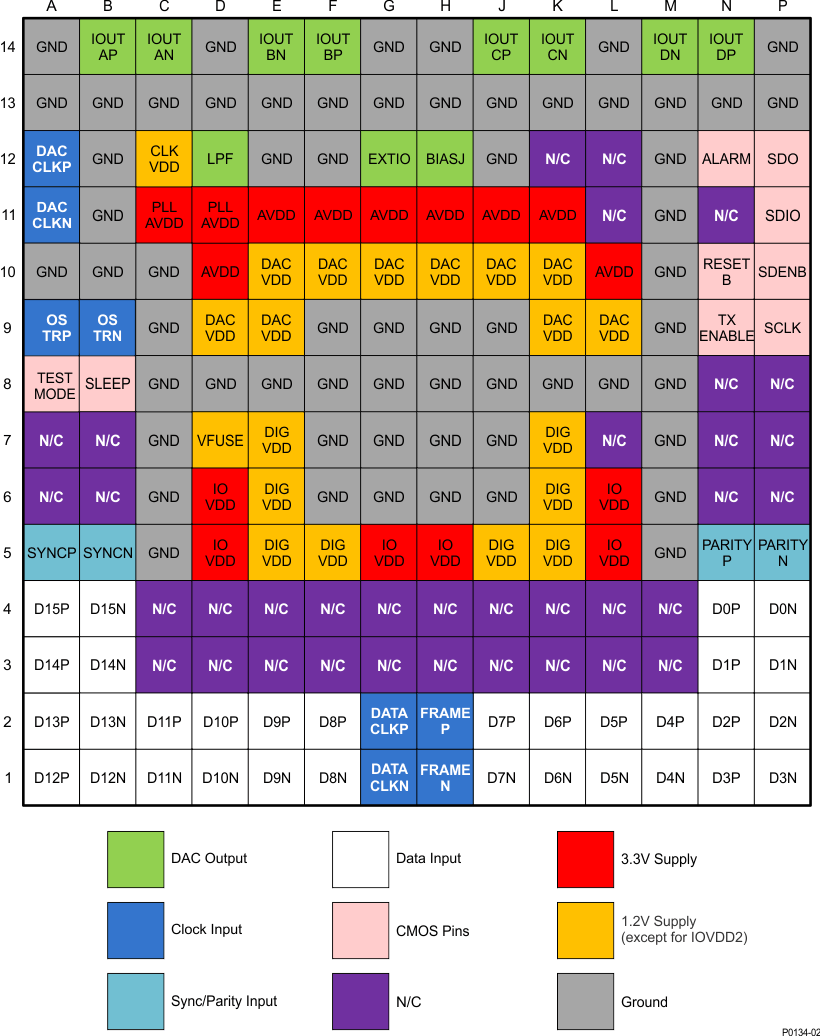| AVDD |
D10, E11, F11, G11, H11, J11, K11, L10 |
I |
Analog supply voltage. (3.3 V) |
| ALARM |
N12 |
O |
CMOS output for ALARM condition. The ALARM output functionality is defined through the config7 register. Default polarity is active low, but can be changed to active high via config0 alarm_out_pol control bit. |
| BIASJ |
H12 |
O |
Full-scale output current bias. For 30-mA full-scale output current, connect 1.28 kΩ to ground. Change the full-scale output current through coarse_dac(3:0) in config3, bit<15:12> |
| CLKVDD |
C12 |
I |
Internal clock buffer supply voltage. (1.2 V)
It is recommended to isolate this supply from DIGVDD and DACVDD. |
| D[15..0]P |
N4, N3, N2, N1, M2, L2, K2, J2, F2, E2, D2, C2, A1, A2, A3, A4 |
I |
LVDS positive input data bits 0 through 15. Internal 100-Ω termination resistor. Data format relative to DATACLKP/N clock is Double Data Rate (DDR). |
|
D15P is most significant data bit (MSB)
D0P is least significant data bit (LSB) |
| The order of the bus can be reversed via config2 revbus bit. |
| D[15..0]N |
P4, P3, P2, P1, M1, L1, K1, J1, F1, E1, D1, C1, B1, B2, B3, B4 |
I |
LVDS negative input data bits 0 through 15. (See D[15:0]P description above) |
| DACCLKP |
A12 |
I |
Positive external LVPECL clock input for DAC core with a self-bias. |
| DACCLKN |
A11 |
I |
Complementary external LVPECL clock input for DAC core. (see the DACCLKP description) |
| DACVDD |
D9, E9, E10, F10, G10, H10, J10, K9, K10, L9 |
I |
DAC core supply voltage. (1.2 V). It is recommended to isolate this supply from CLKVDD and DIGVDD. |
| DATACLKP |
G2 |
I |
LVDS positive input data clock. Internal 100-Ω termination resistor. Input data D[15:0]P/N is latched on both edges of DATACLKP/N (Double Data Rate). |
| DATACLKN |
G1 |
I |
LVDS negative input data clock. (See DATACLKP description) |
| DIGVDD |
E5, E6, E7, F5, J5, K5, K6, K7 |
I |
Digital supply voltage. (1.2 V). It is recommended to isolate this supply from CLKVDD and DACVDD. |
| EXTIO |
G12 |
I/O |
Used as external reference input when internal reference is disabled through config27 extref_ena = 1b. Used as internal reference output when config27 extref_ena = 0b (default). Requires a 0.1-µF decoupling capacitor to AGND when used as reference output. |
| FRAMEP |
H2 |
I |
LVDS frame indicator positive input. Internal 100-Ω termination resistor.
The main functions of this input are to reset the FIFO pointer or to be used as a syncing source. These two functions are captured with the rising edge of DATACLKP/N. The signal captured by the falling edge of DATACLKP/N can be used as a block parity bit. The FRAMEP/N signal should be edge-aligned with D[15:0]P/N.
Additionally it is used to indicate the beginning of the frame. |
| FRAMEN |
H1 |
I |
LVDS frame indicator negative input. (See the FRAMEP description) |
| GND |
A10, A13, A14, B10, B11, B12, B13, C5, C6, C7, C8, C9, C10, C13, D8, D13, D14, E8, E12, E13, F6, F7, F8, F9, F12, F13, G6, G7, G8, G9, G13, G14, H6, H7, H8, H9, H13, H14, J6, J7, J8, J9, J12, J13, K8, K13, L8, L13, L14, M5, M6, M7, M8, M9, M10, M11, M12, M13, N13, P13, P14 |
I |
These pins are ground for all supplies. |
| IOUTAP |
B14 |
O |
A-Channel DAC current output. Connect directly to ground if unused. |
| IOUTAN |
C14 |
O |
A-Channel DAC complementary current output. Connect directly to ground if unused. |
| IOUTBP |
F14 |
O |
B-Channel DAC current output. Connect directly to ground if unused. |
| IOUTBN |
E14 |
O |
B-Channel DAC complementary current output. Connect directly to ground if unused. |
| IOUTCP |
J14 |
O |
C-Channel DAC current output. Connect directly to ground if unused. |
| IOUTCN |
K14 |
O |
C-Channel DAC complementary current output. Connect directly to ground if unused. |
| IOUTDP |
N14 |
O |
D-Channel DAC current output. Connect directly to ground if unused. |
| IOUTDN |
M14 |
O |
D-Channel DAC complementary current output. Connect directly to ground if unused. |
| IOVDD |
D5, D6, G5, H5, L5, L6 |
I |
Supply voltage for all digital I/O. (3.3 V) |
| LPF |
D12 |
I |
PLL loop filter connection. If not using the clock multiplying PLL, the LPF pin can be left unconnected. |
| OSTRP |
A9 |
I |
LVPECL output strobe positive input. This positive/negative pair is captured with the rising edge of DACCLKP/N. It is used for multiple DAC synchronization. If unused it can be left unconnected. |
| OSTRN |
B9 |
I |
LVPECL output strobe negative input. (See the OSTRP description) |
| PARITYP |
N5 |
I |
Optional LVDS positive input parity bit. The PARITYP/N LVDS pair has an internal 100-Ω termination resistor. If unused it can be left unconnected. |
| PARITYN |
P5 |
I |
Optional LVDS negative input parity bit. |
| PLLAVDD |
C11, D11 |
I |
PLL analog supply voltage. (3.3 V) |
| SCLK |
P9 |
I |
Serial interface clock. Internal pull-down. |
| SDENB |
P10 |
I |
Active low serial data enable, always an input to the DAC3484. Internal pull-up. |
| SDIO |
P11 |
I/O |
Serial interface data. Bi-directional in 3-pin mode (default) and 4-pin mode. Internal pull-down. |
| SDO |
P12 |
O |
Uni-directional serial interface data in 4-pin mode. The SDO pin is three-stated in 3-pin interface mode (default). |
| SLEEP |
B8 |
I |
Active high asynchronous hardware power-down input. Internal pull-down. If SLEEP pin is set to logic HIGH before and during device power-up and initialization, the fuse_sleep bit in register 0x1B, bit 11 must be written after register 0x23 during device initialization register setup. |
| SYNCP |
A5 |
I |
Optional LVDS SYNC positive input. The SYNCP/N LVDS pair has an internal 100-Ω termination resistor. If unused it can be left unconnected. |
| SYNCN |
B5 |
I |
LVDS SYNC negative input. |
| RESETB |
N10 |
I |
Active low input for chip RESET, which resets all the programming registers to their default state. Internal pull-up. |
| TXENABLE |
N9 |
I |
Transmit enable active high input. Internal pull-down.
To enable analog output data transmission, set sif_txenable in register config3 to 1b or pull CMOS TXENABLE pin to high.
To disable analog output, set sif_txenable to 0b and pull CMOS TXENABLE pin to low. The DAC output is forced to midscale. |
| TESTMODE |
A8 |
O |
This pin is used for factory testing. Internal pull-down. Leave unconnected for normal operation. |
| VFUSE |
D7 |
I |
Digital supply voltage. This supply pin is also used for factory fuse programming. Connect to DACVDD for normal operation. |

